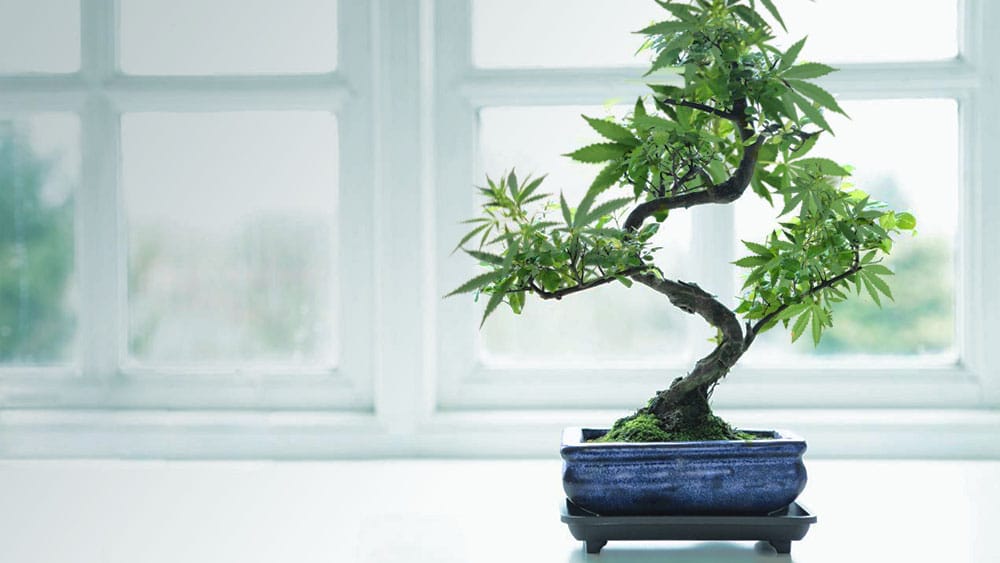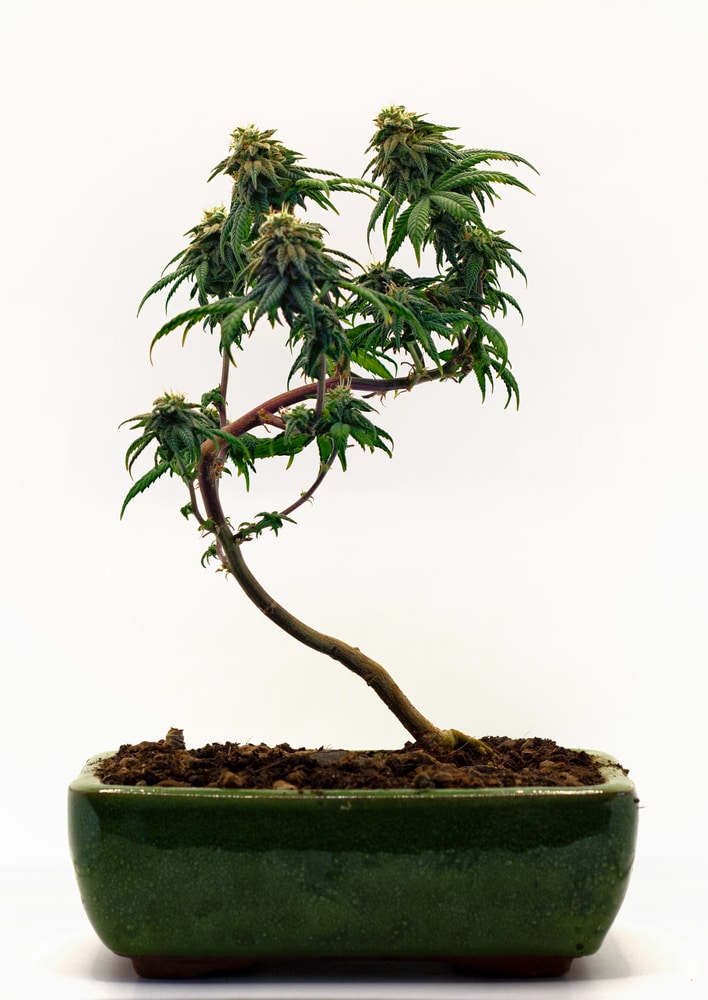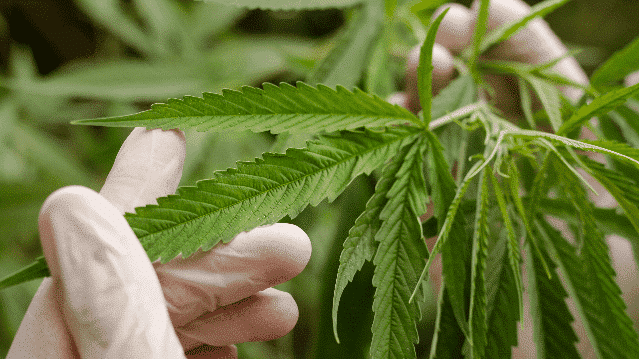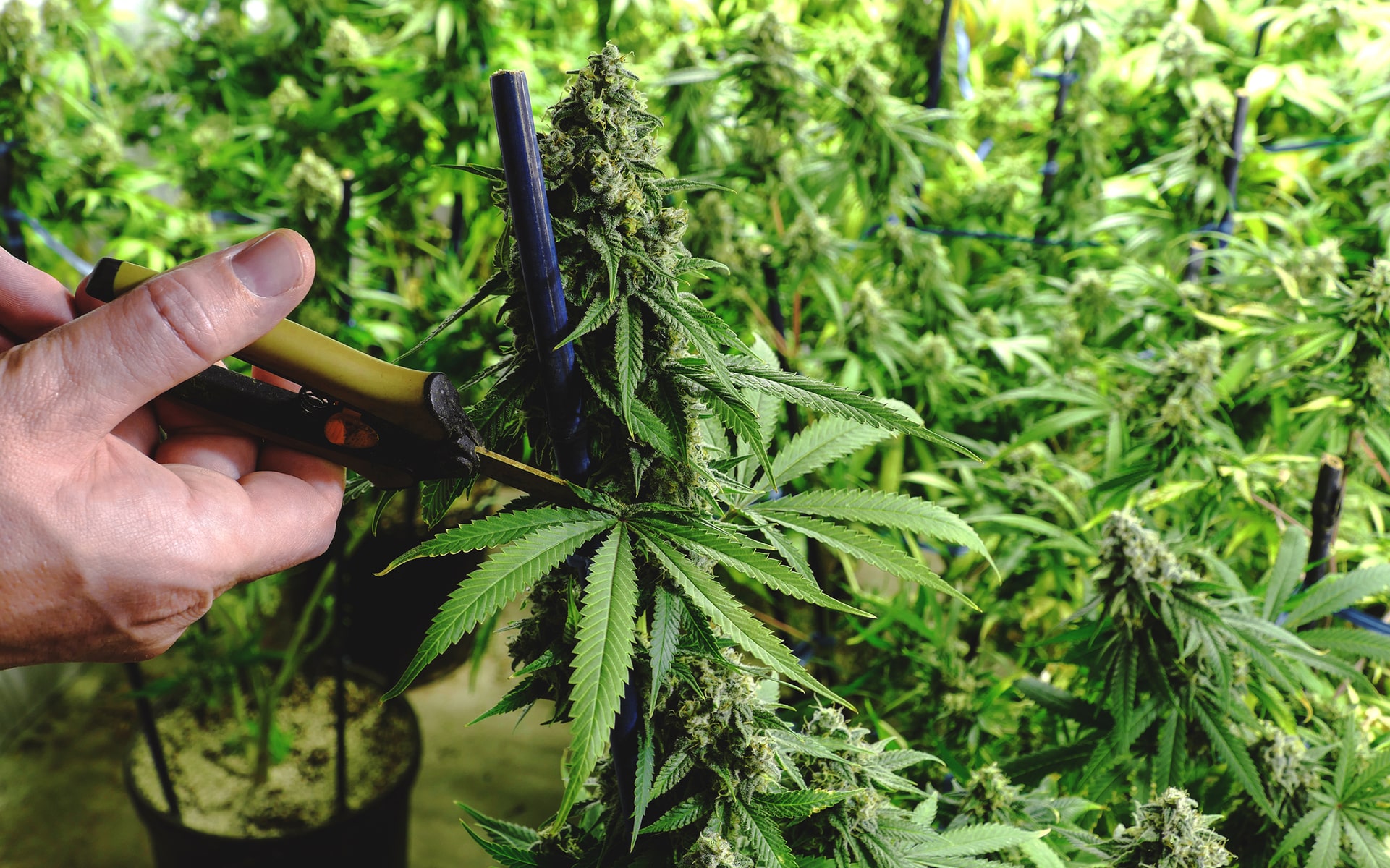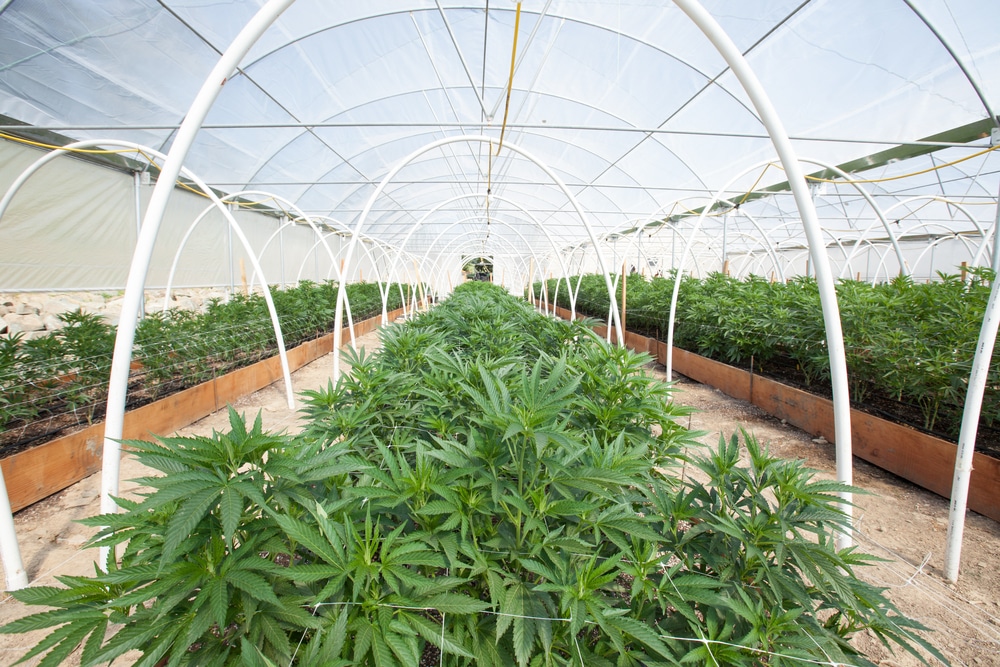No products in the cart.
Marijuana Education
Growing Green: A Step-by-Step Guide on How to Cultivate a Cannabis Bonsai Tree
Are you interested in learning how to grow a cannabis bonsai tree?
Believe it or not, you can cultivate miniature marijuana trees that are not only aesthetically pleasing but also have practical benefits.
Canna-bonsai, or “budsai,” are gaining popularity because they are perfect for smaller spaces and can result in stable genetics that will benefit future cultivation efforts. In addition to being a fascinating art form, growing a cannabis bonsai tree is also associated with spiritual and mental well-being.
Join us as we explore the tradition of bonsai, the art of cultivating miniature trees, and how to grow your very own cannabis bonsai tree.
How to Cultivate a Cannabis Bonsai Tree
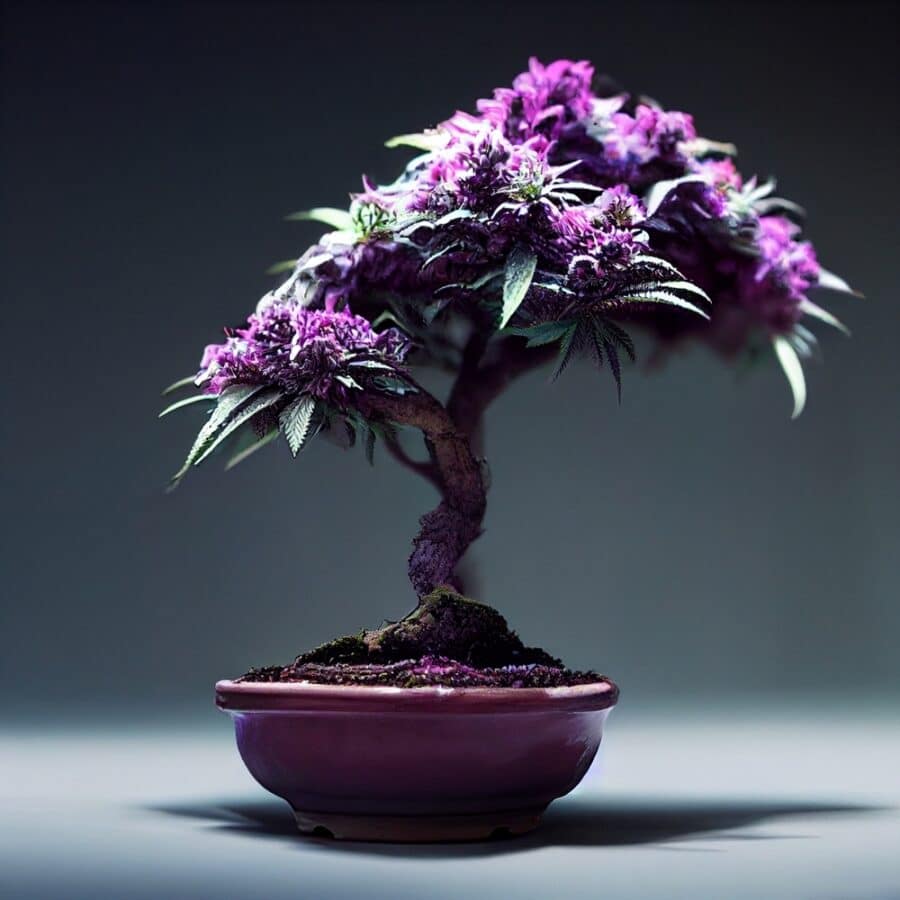
The word bonsai isn’t related to a specific species but refers to cultivating miniature versions of ornamental plants and trees. It originated in Japan and China, where it’s both an art form and a method of plant cultivation.
Bonsai culture is rooted in China, where locals began creating pen-jing, or miniature landscapes, over 2,000 years ago. They believed the small-scale reproductions of natural scenery possessed magical properties that transferred to anyone focusing on them.
People believe the art and gardening of bonsai can lead to improved health and well-being, as well as spiritual enlightenment.
It’s also a form of Wabi-sabi, an art style celebrating change, imperfect beauty, and nature’s growth, decay, and death cycles.
Since bonsai builds on Zen principles, it’s unsurprising that it works well with cannabis.
Many weed users claim that marijuana provides them with glimpses of enlightenment and enhanced feelings of calm and acceptance. People who engage in canna-bonsai say it enhances their understanding and relationship with the plant.
What is a cannabis bonsai tree?
A marijuana bonsai is a cannabis plant grown in a container and pruned to resemble a miniature tree.
Various weed strains may respond differently to the technique, but you can usually transform any type into a bonsai with the proper care and procedures.
People cultivate weed bonsai to obtain clone cuttings and because they occupy significantly less room than mature cannabis plants.
What cultural traditions support bonsai?
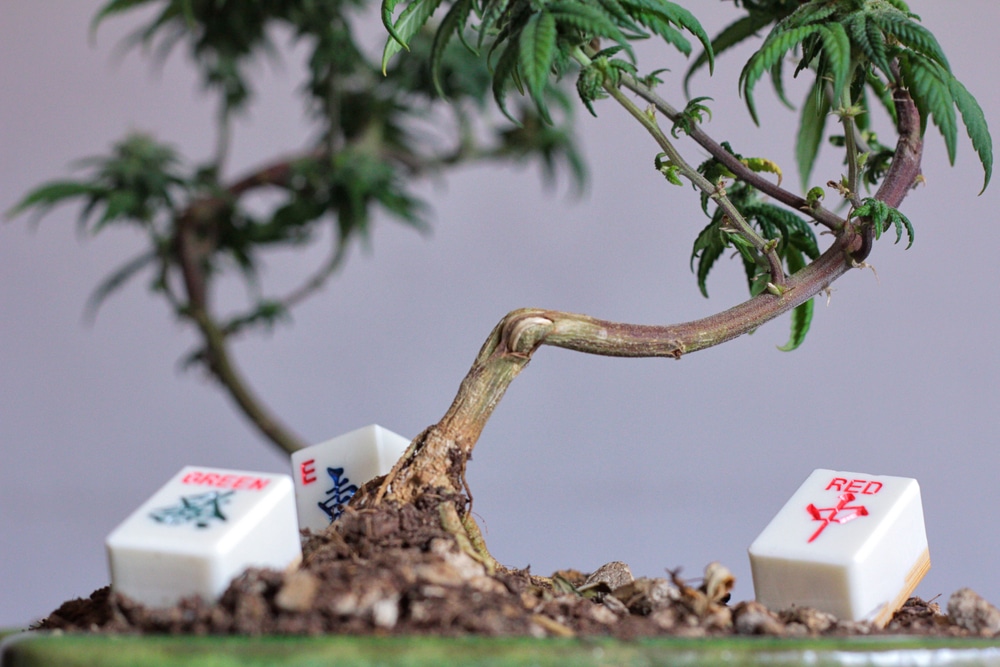
The Japanese saying kachu fugetsu translates to “flower, bird, wind, moon.” These words have a deeper meaning: Individuals can learn more about themselves through observing and internalizing nature’s marvels.
The term bonsai became associated with kachu fugetsu. The practice aligns with the notion that planting miniature trees is a quiet, tranquil, reflective art that helps people connect with nature.
Zen Buddhism and growing bonsai became closely related and popular during Japan’s Kamakura period.
According to historians, Buddhist monks in Japan were the primary bonsai instructors for a long time. Zen is one of their religious practices, yet many non-Buddhists appreciate the philosophy underlying it.
According to traditional bonsai cultivation, one must possess some Zen values to produce a successful, authentic plant.
First, human hands should guide the tree’s growth without blatant manipulation. Additionally, it needs to grow slightly off-center, as the Buddhists believe the pot’s midpoint is where heaven and earth meet.
The tree can impact the grower’s way of thinking and positively influence their state of mind. Caregiving becomes a daily time for reflection and meditation.
Why grow marijuana bonsai plants?
Bonsai differs from other potted plants because you create and appreciate a nature-resembling miniature landscape’s intricate details and beauty.
The long and fascinating history of bonsai dates back to China and Japan, where it may have originated as early as 700 A.D.
Besides enabling you to grow in a limited space, it also provides a way of connecting with nature.
Cannabis bonsai trees also have valuable clone clippings, allowing you to maintain their genetic stability in future grows.
Historical evidence shows attempts to alter normal plants in ways similar to canna bonsais. Some approaches change the appearance of a plant from its natural condition.
Even though people primarily used these training techniques for purposes other than art, they had the same intentions: to deliberately reduce the size of the plant and create a portable oasis.
Growers have long retained bonsai “mothers,” plants kept intentionally small by pruning them to create clones for future cultivation. Doing this helps to preserve genetic lines and specific traits.
Tips for growing your own cannabis bonsai
The following tips may help you out when venturing into growing cannabis bonsai:
- Select a cannabis strain that thrives in small spaces.
- Grow it in a pot at least 10 inches in width and depth.
- Plant your cannabis bonsai in any container, but a ceramic pot is more suitable to facilitate drainage and airflow.
Growing your cannabis bonsai tree
Now it’s time to start creating your personal marijuana bonsai. Follow our guide below for the best results.
Preparing the grow pot
Grab a small container or pot with several drainage holes to prepare your plant’s home.
Some growers prefer drilling holes around the container’s rim to use string or gardening twine to train the plant.
Layer several clean pebbles or rocks at the bottom of the pot, then fill it with your chosen growing medium.
Training the trunk
Place a robust and healthy mother plant in the pot, then insert a wooden stake in the soil alongside the main stem. Doing so helps to guide it in any desired direction and promote horizontal or vertical growth.
Take care at this point to protect the roots from damage. Use string or twine to connect the stem to the stake by feeding it through the holes at the bottom of the pot.
Branch topping and training
Begin trimming and shaping your cannabis plant when it’s approximately six inches tall and starts producing stems or branches in its vegetative state.
Use sharp scissors or pruning shears to remove any additional leaves or branches, and try to give your tree a single main trunk, making it appear more natural.
Topping is where you remove the very tip of the main stem. In response, the plant produces additional side branches for you to train into a specific shape.
Keep the branches in place or fasten them during training so it grows in the proper direction. There are numerous ways to accomplish this, including bending, tying, or wiring.
By carefully directing its growth, you can sculpt your miniature cannabis plant into any desired form. Fellow growers often make it grow horizontally or cause it to wind into a specific shape.
Pruning
Implementing pruning practices lets you manage cannabis plants, boost yields, improve airflow, and control infections and diseases. It also helps to keep them growing bigger and taking up too much space.
Start by cutting off dying or dead leaves and excess growth. Then, trim away a third of the main branches without removing them, as doing so could cause stress and restrict growth.
Cut the top to the desired height and remove any fan leaves that do more harm than good.
Prune offshoot branches and larger leaves until only the smaller ones remain. Once you’ve achieved the classic bonsai shape you want, tend to the soil to ensure healthy roots.
You might also need to prune the roots, as the plants could suffocate if transplanted into small containers.
Time for harvest
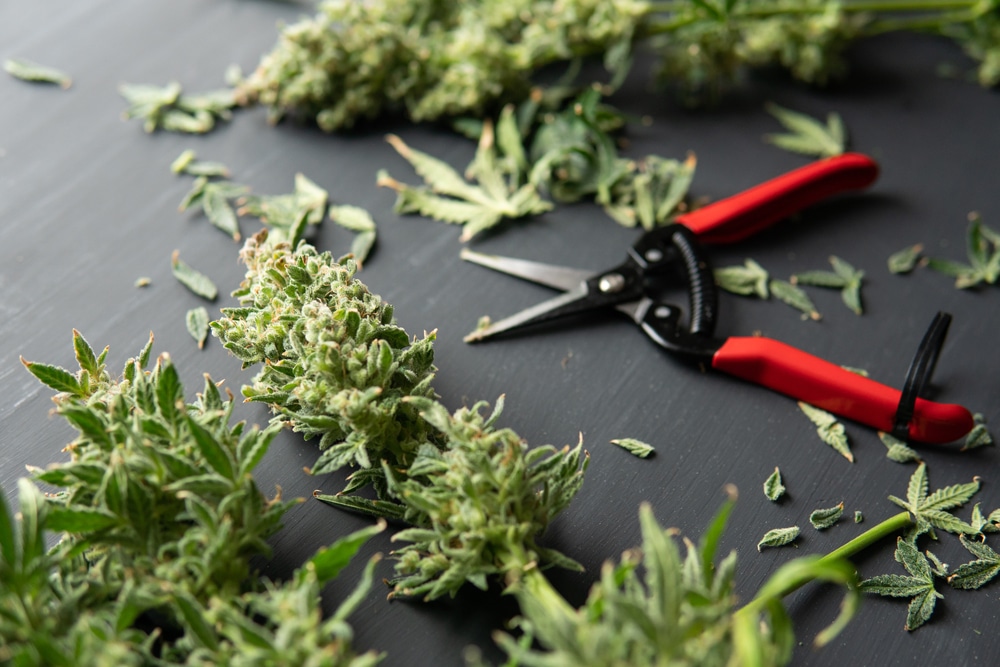
Your marijuana bonsai tree will go through the typical growth phases and start flowering, producing tiny buds between the trunk and branch. These indicators tell you that your healthy plant has entered the blooming season.
If you leave it for too long, it may develop into a male and produce more seeds. Tiny balls, known as pollen sacs, start appearing. They resemble hanging bananas when maturing, although the appearance may vary with different strains.
If this happens, don’t discard the bonsai even after the harvest period, as you can use the male parts as mulch for other plants.
The female cannabis tree is the most popular form, as it starts producing quality buds for consumption.
The flower has a slightly different appearance from males. When the pistils extend upward, they resemble hairs pointing to the sky. Allow these to mature until they become a creamy white tint, indicating the plant is ready for harvest.
Which strains are best for growing a cannabis bonsai tree?
Now that you understand more about bonsai growing, which are the best weed plants for the task?
Technically, you can create a weed bonsai tree from any strain with sufficient effort and time, but short hybrids and indicas make it easier.
Below are the top cultivar choices to grow cannabis bonsai trees.
White Widow
White Widow combines indica and sativa growth patterns and produces a compact plant, making it the perfect choice to grow a marijuana bonsai. It has a short flowering time and is highly resistant to molds, pests, and diseases.
This short beauty is simple to maintain with minimal pruning and support wires.
Critical Kush
Critical Kush boasts a short, bushy structure that can withstand climate change and most health problems.
It has several leaves and grows laterally, giving you numerous possibilities for planning and designing your canna bonsai.
Ensure that your Critical Kush plants receive sufficient airflow and feed them generously.
Big Bud
Big Bud is a predominantly indica, high-yielding, and easy-to-grow strain. It’s robust, durable, and resistant to mildew, insects, mold, and disease.
It’s ideal for a simpler weed bonsai shape because it has fewer leaves and several bud-growing sites. Use low-stress training to shape it how you want to, and you’ll appreciate its compact size and resilience in harsh conditions.
Pay tribute to the ancient art form by growing cannabis bonsai trees
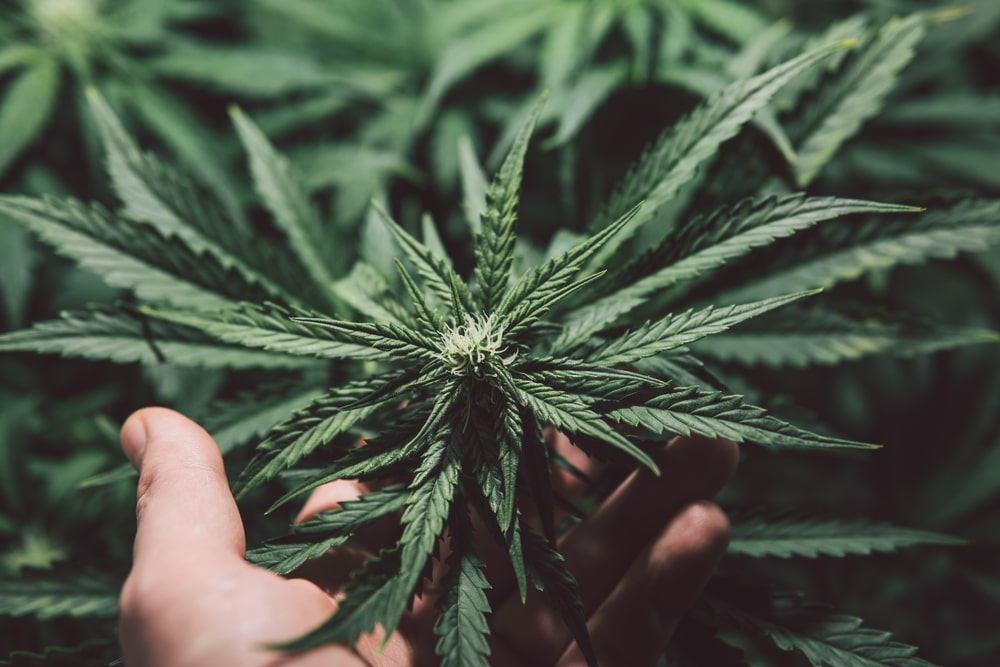
Growing your own cannabis bonsai is easy, and if you haven’t done it before, it’s an art form every weed enthusiast should try at least once.
Remember to place your plant in a small pot and use training techniques to achieve your desired shape. Use a wooden stake to support it in organic soil, and cut new offshoot branches to keep it manageable.
Choose a short-growing strain for small spaces, and spend time with it each day to experience the spiritual and mental benefits of watching it blossom.
Visit The Seed Fair to purchase the best hand-selected marijuana seeds and sow them to grow your own canna bonsai. We have a wide selection of strains for all preferences and a blog packed with helpful resources for all things weed.
Frequently asked questions about cannabis bonsai
Have you got leftover questions about cultivating cannabis bonsai trees? Check out these common queries below to find additional answers.
How long does a canna bonsai last?
A cannabis bonsai plant can live between three and five years and produce leaves and buds continuously throughout its lifespan with proper care.
Many growers maintain a single cannabis plant longer than the usual life cycle, but it depends on the strain you’re growing and its environment.
How many months does it take to grow a cannabis plant?
Weed can take 10–32 weeks, or approximately three to eight months, from germination to harvest. Starting with clone clippings or an autoflowering strain may accelerate the process.
The marijuana plant’s development is most rapid during the vegetative phase, but you get proper bud production toward the end of the flowering stage.
Do marijuana bonsai trees smell bad?
Like typical marijuana plants, canna bonsais may emit strong scents because of their terpenes and fresh buds. You won’t have any issues with the smell if you’ve reaped a cannabis grow before, but others may not enjoy the fragrance as you do.
Utilize fans and room sprays, and consider guerilla growing if you think the aromas will cause problems with outsiders.


